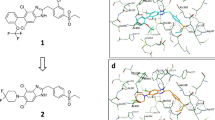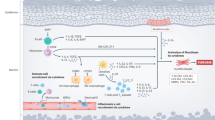Abstract
Recent advances of biotechnology have laid the groundwork for potent and specific molecular-targeting therapies including RNA interference. The largest remaining hurdle for widespread use of this technology in skin is an effective delivery system. Here, we demonstrate an effective topical delivery system using a cream formulation containing a small-interfering RNA (siRNA) that specifically targets osteopontin (OPN). OPN is a validated target in numerous inflammatory diseases, including rheumatoid arthritis (RA). The siRNA targeting OPN was incorporated into a cream formulation GeneCream that penetrates the stratum corneum, depositing siRNA in the epidermis, dermis, and to a lesser extent, subcutaneous tissue. In addition, when the OPN siRNA cream was topically applied to the skin of a collagen antibody-induced RA mouse model, the siRNA cream prevented the occurrence of severe, irreversible damage to bone and cartilage. Thus, the siRNA cream provides effective delivery of active OPN siRNA, suggesting this formulation may represent a platform technology for delivery of siRNAs for treating various disorders including RA.
This is a preview of subscription content, access via your institution
Access options
Subscribe to this journal
Receive 12 print issues and online access
$259.00 per year
only $21.58 per issue
Buy this article
- Purchase on Springer Link
- Instant access to full article PDF
Prices may be subject to local taxes which are calculated during checkout




Similar content being viewed by others
References
Dykxhoorn DM, Lieberman J . Knocking down disease with siRNAs. Cell 2006; 126: 231–235.
McCaffrey AP, Meuse L, Pham TT, Conklin DS, Hannon GJ, Kay MA . RNA interference in adult mice. Nature 2002; 418: 38–39.
Soutschek J, Akinc A, Bramlage B, Charisse K, Constien R, Donoghue M et al. Therapeutic silencing of an endogenous gene by systemic administration of modified siRNAs. Nature 2004; 432: 173–178.
Takeshita F, Minakuchi Y, Nagahara S, Honma K, Sasaki H, Hirai K et al. Efficient delivery of small interfering RNA to bone-metastatic tumors by using atelocollagen in vivo. Proc Natl Acad Sci USA 2005; 102: 12177–12182.
Zimmermann TS, Lee AC, Akinc A, Bramlage B, Bumcrot D, Fedoruk MN et al. RNAi-mediated gene silencing in non-human primates. Nature 2006; 441: 111–114.
Kumar P, Wu H, McBride JL, Jung KE, Kim MH, Davidson BL et al. Transvascular delivery of small interfering RNA to the central nervous system. Nature 2007; 448: 39–43.
Zhang Q, Zhang ZF, Rao JY, Sato JD, Brown J, Messadi DV et al. Treatment with siRNA and antisense oligonucleotides targeted to HIF-1alpha induced apoptosis in human tongue squamous cell carcinomas. Int J Cancer 2004; 111: 849–857.
Bitko V, Musiyenko A, Shulyayeva O, Barik S . Inhibition of respiratory viruses by nasally administered siRNA. Nat Med 2005; 11: 50–55.
Zhang X, Shan P, Jiang D, Noble PW, Abraham NG, Kappas A et al. Small interfering RNA targeting heme oxygenase-1 enhances ischemia-reperfusion-induced lung apoptosis. J Biol Chem 2004; 279: 10677–10684.
Reich SJ, Fosnot J, Kuroki A, Tang W, Yang X, Maguire AM et al. Small interfering RNA (siRNA) targeting VEGF effectively inhibits ocular neovascularization in a mouse model. Mol Vis 2003; 9: 210–216.
Pfutzner W, Vogel JC . Advances in skin gene therapy. Expert Opin Investig Drugs 2000; 9: 2069–2083.
Khavari PA, Rollman O, Vahlquist A . Cutaneous gene transfer for skin and systemic diseases. J Intern Med 2002; 252: 1–10.
Hengge UR, Walker PS, Vogel JC . Expression of naked DNA in human, pig, and mouse skin. J Clin Invest 1996; 97: 2911–2916.
Vogel JC . A direct in vivo approach for skin gene therapy. Proc Assoc Am Phys 1999; 111: 190–197.
Raghavachari N, Fahl WE . Targeted gene delivery to skin cells in vivo: a comparative study of liposomes and polymers as delivery vehicles. J Pharm Sci 2002; 91: 615–622.
Prud'homme GJ, Glinka Y, Khan AS, Draghia-Akli R . Electroporation-enhanced nonviral gene transfer for the prevention or treatment of immunological, endocrine and neoplastic diseases. Curr Gene Ther 2006; 6: 243–273.
Takei Y, Nemoto T, Mu P, Fujishima T, Ishimoto T, Hayakawa Y et al. In vivo silencing of a molecular target by short interfering RNA electroporation: tumor vascularization correlates to delivery efficiency. Mol Cancer Ther 2008; 7: 211–221.
Patarca R, Freeman GJ, Singh RP, Wei FY, Durfee T, Blattner F et al. Structural and functional studies of the early T lymphocyte activation 1 (Eta-1) gene. Definition of a novel T cell-dependent response associated with genetic resistance to bacterial infection. J Exp Med 1989; 170: 145–161.
Weber GF, Cantor H . The immunology of Eta-1/osteopontin. Cytokine Growth Factor Rev 1996; 7: 241–248.
Ashkar S, Weber GF, Panoutsakopoulou V, Sanchirico ME, Jansson M, Zawaideh S et al. Eta-1 (osteopontin): an early component of type-1 (cell-mediated) immunity. Science 2000; 287: 860–864.
O'Regan AW, Nau GJ, Chupp GL, Berman JS . Osteopontin (Eta-1) in cell-mediated immunity: teaching an old dog new tricks. Immunol Today 2000; 21: 475–478.
Yumoto K, Ishijima M, Rittling SR, Tsuji K, Tsuchiya Y, Kon S et al. Osteopontin deficiency protects joints against destruction in anti-type II collagen antibody-induced arthritis in mice. Proc Natl Acad Sci USA 2002; 99: 4556–4561.
Xu G, Nie H, Li N, Zheng W, Zhang D, Feng G et al. Role of osteopontin in amplification and perpetuation of rheumatoid synovitis. J Clin Invest 2005; 115: 1060–1067.
Yamamoto N, Sakai F, Kon S, Morimoto J, Kimura C, Yamazaki H et al. Essential role of the cryptic epitope SLAYGLR within osteopontin in a murine model of rheumatoid arthritis. J Clin Invest 2003; 112: 181–188.
Xanthou G, Alissafi T, Semitekolou M, Simoes DC, Economidou E, Gaga M et al. Osteopontin has a crucial role in allergic airway disease through regulation of dendritic cell subsets. Nat Med 2007; 13: 570–578.
Hopewell JW . The skin: its structure and response to ionizing radiation. Int J Radiat Biol 1990; 57: 751–773.
Valoczi A, Hornyik C, Varga N, Burgyan J, Kauppinen S, Havelda Z . Sensitive and specific detection of microRNAs by northern blot analysis using LNA-modified oligonucleotide probes. Nucleic Acids Res 2004; 32: e175.
Wienholds E, Kloosterman WP, Miska E, Alvarez-Saavedra E, Berezikov E, de Bruijn E et al. MicroRNA expression in zebrafish embryonic development. Science 2005; 309: 310–311.
Wang Q, Ilves H, Chu P, Contag CH, Leake D, Johnston BH et al. Delivery and inhibition of reporter genes by small interfering RNAs in a mouse skin model. J Invest Dermatol 2007; 127: 2577–2584.
Thanik VD, Greives MR, Lerman OZ, Seiser N, Dec W, Chang CC et al. Topical matrix-based siRNA silences local gene expression in a murine wound model. Gene Therapy 2007; 14: 1305–1308.
Shanahan JC, St Clair W . Tumor necrosis factor-alpha blockade: a novel therapy for rheumatic disease. Clin Immunol 2002; 103: 231–242.
Park JY, Pillinger MH . Interleukin-6 in the pathogenesis of rheumatoid arthritis. Bull NYU Hos Jt Dis 2007; 65 (Suppl 1): S4–S10.
Koenders MI, Joosten LA, van den Berg WB . Potential new targets in arthritis therapy: interleukin (IL)-17 and its relation to tumour necrosis factor and IL-1 in experimental arthritis. Ann Rheum Dis 2006; 65 (Suppl 3): iii29–iii33.
Weinblatt ME, Kremer JM, Bankhurst AD, Bulpitt KJ, Fleischmann RM, Fox RI et al. A trial of etanercept, a recombinant tumor necrosis factor receptor:Fc fusion protein, in patients with rheumatoid arthritis receiving methotrexate. N Engl J Med 1999; 340: 253–259.
Lipsky PE, van der Heijde DM, St Clair EW, Furst DE, Breedveld FC, Kalden JR et al. Infliximab and methotrexate in the treatment of rheumatoid arthritis. Anti-Tumor Necrosis Factor Trial in Rheumatoid Arthritis with Concomitant Therapy Study Group. N Engl J Med 2000; 343: 1594–1602.
Weinblatt ME, Keystone EC, Furst DE, Moreland LW, Weisman MH, Birbara CA et al. Adalimumab, a fully human anti-tumor necrosis factor alpha monoclonal antibody, for the treatment of rheumatoid arthritis in patients taking concomitant methotrexate: the ARMADA trial. Arthritis Rheum 2003; 48: 35–45.
Nishimoto N, Yoshizaki K, Maeda K, Kuritani T, Deguchi H, Sato B et al. Toxicity, pharmacokinetics, and dose-finding study of repetitive treatment with the humanized anti-interleukin 6 receptor antibody MRA in rheumatoid arthritis. Phase I/II clinical study. J Rheumatol 2003; 30: 1426–1435.
Nishimoto N, Yoshizaki K, Miyasaka N, Yamamoto K, Kawai S, Takeuchi T et al. Treatment of rheumatoid arthritis with humanized anti-interleukin-6 receptor antibody: a multicenter, double-blind, placebo-controlled trial. Arthritis Rheum 2004; 50: 1761–1769.
Gomez-Reino JJ, Carmona L, Valverde VR, Mola EM, Montero MD . Treatment of rheumatoid arthritis with tumor necrosis factor inhibitors may predispose to significant increase in tuberculosis risk: a multicenter active-surveillance report. Arthritis Rheum 2003; 48: 2122–2127.
Wolfe F, Michaud K . Lymphoma in rheumatoid arthritis: the effect of methotrexate and anti-tumor necrosis factor therapy in 18,572 patients. Arthritis Rheum 2004; 50: 1740–1751.
Mader R, Keystone E . Optimizing treatment with biologics. J Rheumatol Suppl 2007; 80: 16–24.
van Ede AE, Laan RF, Blom HJ, De Abreu RA, van de Putte LB . Methotrexate in rheumatoid arthritis: an update with focus on mechanisms involved in toxicity. Semin Arthritis Rheum 1998; 27: 277–292.
Imokawa S, Colby TV, Leslie KO, Helmers RA . Methotrexate pneumonitis: review of the literature and histopathological findings in nine patients. Eur Respir J 2000; 15: 373–381.
Saito Y, Kon S, Fujiwara Y, Nakayama Y, Kurotaki D, Fukuda N et al. Osteopontin small interfering RNA protects mice from fulminant hepatitis. Hum Gene Ther 2007; 18: 1205–1214.
Terato K, Hasty KA, Reife RA, Cremer MA, Kang AH, Stuart JM . Induction of arthritis with monoclonal antibodies to collagen. J Immunol 1992; 148: 2103–2108.
Acknowledgements
This study was supported by grants-in-aids from the Ministry of Education, Culture, Sports, Science and Technology of Japan; the Ministry of Health, Labour and Welfare of Japan; Japan Health Sciences Foundation; a grant from Yamaguchi Endocrine Research Association and the grant from ‘University–Industry Joint Research Project’ for private universities as well as a matching fund subsidy from the MEXT (Ministry of Education, Culture, Sports, Science and Technology, 2007–2009).
Author information
Authors and Affiliations
Corresponding author
Rights and permissions
About this article
Cite this article
Takanashi, M., Oikawa, K., Sudo, K. et al. Therapeutic silencing of an endogenous gene by siRNA cream in an arthritis model mouse. Gene Ther 16, 982–989 (2009). https://doi.org/10.1038/gt.2009.66
Received:
Revised:
Accepted:
Published:
Issue Date:
DOI: https://doi.org/10.1038/gt.2009.66
Keywords
This article is cited by
-
Osteopontin in autoimmune disorders: current knowledge and future perspective
Inflammopharmacology (2022)
-
Role of osteopontin in rheumatoid arthritis
Rheumatology International (2015)
-
Keratin 17 is co-expressed with 14-3-3 sigma in oral carcinoma in situ and squamous cell carcinoma and modulates cell proliferation and size but not cell migration
Virchows Archiv (2015)
-
Perspectives on Using Nanoscale Delivery Systems in Dermatological Treatment
Current Dermatology Reports (2015)
-
siRNA-based therapeutic approaches for rheumatic diseases
Nature Reviews Rheumatology (2013)



